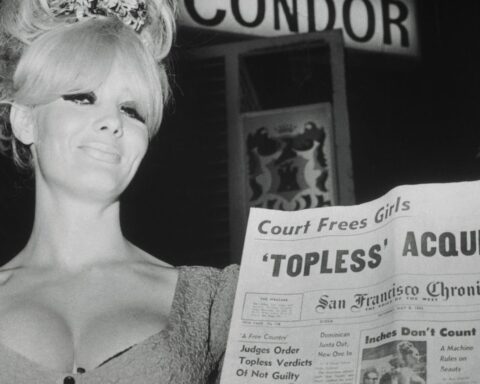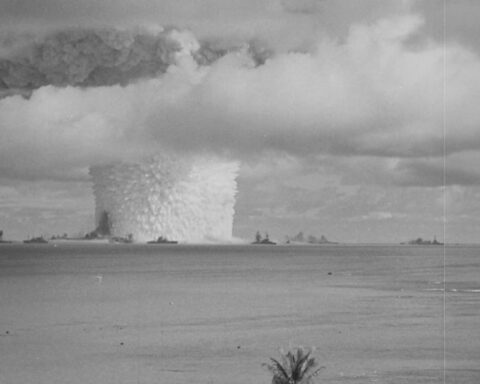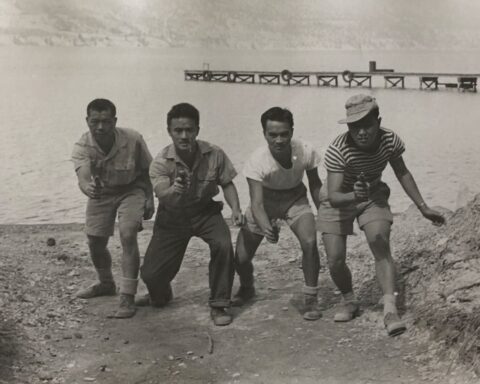It’s a new age when an archivist takes centre stage, even one as unique as Rick Prelinger. At the 2011 Full Frame Documentary Festival in Durham, North Carolina, Prelinger curated and presented “One Foot in the Archives”, a series that cast an illuminating shadow over all the festival films. And the oxymoron is apt, as he demonstrated that archival materials have grown from minor interludes or narrowly interpreted loops to become the narrative marrow and aesthetic backbone of several contemporary documentaries.
Consider the variety of records on display among the pictures not programmed by Prelinger: 10 hours of videotaped interrogation is at the core of the festival grand jury winner, Scenes of a Crime (2011, dirs. Grover Babcock and Blue Hadaegh). Footage of the legendary, though perhaps not landmark, cross-country journey taken in 1964 by Ken Kesey and the Merry Pranksters constitutes the foundation of Magic Trip (2010, dirs. Alex Gibney and Alison Ellwood). One of the most harrowing scenes in The Interrupters (2011, dir. Steve James), winner of the Center for Documentary Studies’ special jury award, is a raw video of 16-year-old Derrion Albert being slugged with a wooden plank, part of a beating from which the black teen later died. This snippet, among other passing horrors on YouTube, contrasts with the raunchy headlines from the British Sun and Daily Mirror, tantalizing snatches of TV, and fairy-tale-as-home-movie from the diverting adventures of Joyce McKinney in Tabloid (2010, dir. Errol Morris). And while providing only limited insight into its subject’s filmmaking operations, Corman’s World (2011, dir. Alex Stapleton) rolls along with testimonials from his collaborators spiced with excerpts from his unapologetically low-budget oeuvre to measure the longevity and surprising dignity of the auteur.
The diversity of archival materials, and their possible uses in documentaries, has only recently ripened. According to Prelinger’s essay in the festival booklet, both the sources and uses of archival footage were significantly more limited when he started collecting: “Everything was newsreels, newsreels, newsreels, with a heavy dose of SignalCorps combat footage…When I founded Prelinger archives in 1982, there were several dozen major sources for archival footage…all were pretty much inaccessible to filmmakers without large budgets. Today there are thousands of footage sources in North America…[and] now a critical mass of inexpensive or free interesting archival material available online for almost anyone who wants to use it.”
Prelinger’s programme could have started in the silent era, with the significant use of archival materials in rewriting history, from Esfir Shub’s Soviet compilation films of Czarist Russia such as The Fall of the Romanov Dynasty (1927) to the works of Emile de Antonio in the 1960s and ’70s. These examples deserved a place if more could have been screened, as well as a film that demonstrated how archival materials were conventionally used before Prelinger founded his collection. Festival audiences could then have seen how far archival images have come in documentary, from illustrations of the voice of God to the point where a media archaeologist, as Prelinger says he has been called, can create a series and express with credible optimism that “this is the most interesting time to be alive.”
Despite the ongoing difficulties in locating and scanning archival material, in support of Prelinger’s optimism, never before has such a diverse amount been available without setting foot in an archive. As he notes, the contemporary range of these online sources goes far beyond historical fiction films and newsreels to “home movies, outtakes, advertising,training, educational and industrial films, and the other bastard genres,” in colour as well as in black and white.
The question is how to translate this potential access into public awareness. Individual searches at a computer are the popular solitary way, but there are now attempts at “strikingly enlightened use[s]” of archival materials to reinvigorate public life, as the British Film Institute has done with the establishment of five free mediatheques, four of them outside of London (according to Sean O’Brien in “Full of Folk: Treasures of the BFI’s latest mediatheque,” Times Literary Supplement, October 29, 2010). The Northern Ireland Film and Television Commission further demonstrated how archival materials may stimulate education. Its recent initiative “Creative Learning in the Digital Age” apprenticed school children as documentarians by having them employ footage from the national archive’s collections in school reports on social issues of the country. That the programme has now run out of funds only points to the importance of acting on the spirit of outreach.
Prelinger’s activities lead these trends. Sharing archival materials with the public is “the only way I want to work now,” he told me, regarding his Full Frame screening of Lost Landscapes of Detroit (2010). This ongoing project is distinguished by its mode of exhibition, as Prelinger told the festival audience before the screening: “You are going to be responsible for making the soundtrack.” He asked the spectators to identify the Detroit locations they saw onscreen, respond to other people’s comments, and ask questions about the footage, to which he is constantly adding as he finds new materials.
His screening addressed the related issues for archival sources, of how to keep them before the public, in all their diversity. Tom Johnson, co-producer and director of America Lost and Found (1979), observed that the same footage of 1930s America was used both in his film and in Brother, Can You Spare a Dime? (U.K., 1975, dir. Philippe Mora), a documentary also programmed by Prelinger that covers the same period in the same country. As Johnson noted, the same historical images tend to be recycled because of low cost and ease of licensing, until they become iconic.
While no new piece of footage was identified, the Detroit screening illustrated how audiences can be drawn to new sources of archival material, anticipating what they might say over the next segment of amateur, industrial, advertising, educational, instructional or training film. The Durham crowd of former Detroiters expressed more nostalgia thaninsight, with some wit (“early June,” quipped one man over a shot of snow-covered suburbs). Yet it is instructive to imagine how the reactions of viewers to the recent films about the Michigan city— Requiem for Detroit? (U.K., 2010, dir. Julien Temple) and Detroit Wild City (France, 2010, dir. Florent Tillon)—compare to the festival filmgoers’ recognition of how parts of their past were found in, and might still be retrieved from, caches of cinema.
To Prelinger, “archives are only going to start to sing when people stop thinking about them only historically.” In its footage and format, the Detroit screening was meant to impel spectators forward, to “share their views on the future of this highly troubled, yet extremely dynamic city,” according to his programme note. His series as a whole demonstrated filmmakers’ growing confidence in the use of archival footage without extraneous commentary, from the compilations of 1930s Americana to The Autobiography of Nicolae Ceausescu (2010, Romania, dir. Andrei Ujica), a three-hour proof of how changing understandings of history, without any prompting in the film, caused spectators to read against the original intentions of its footage, uncovering in celebrations of the dictator the theatre of his rule.
Yet as Prelinger noted, immediately following his screening of the movie, he went to read the Wikipedia entries on Ceausescu and Romania. While archival footage has gained independence from its conventional role as historical wallpaper, he claims it still needs to balance between “giving context…and exciting the imagination.” How weighty an anchor does archival footage demand?
The answer naturally varies: as the end credits to Corman’s World show, excerpts from the producer-director’s films are more entertaining when taken out of context. On the other hand, the attempt to show the continuing significance of the black power movement is only partly successful in The Black Power Mixtape (2011, Sweden, dir. Göran Hugo Olsson), despite having scholar Cornel West, singer Erykah Badu and other contemporary cultural figures voiceover the compelling footage of a genteel Stokely Carmichael and other articulate black leaders, including Angela Davis, in jail. For while not evident in its title, The Black Power Mixtape is a Swedish film about black America. Swedish crews shot all of the material, and their concerns determined the footage, from the shot of Martin Luther King, Jr., receiving the Nobel Prize from King Olaf to a segment on a TV Guide article criticizing Swedish TV as the most anti-American of all European broadcasters. Besides the contemporary black speakers, Swedish commentary on the film would bring viewers more historical context and excitement, to understand how the past movement is more than a concern of African-Americans, but also of equal and sometimes greater interest to other countries.
The potential in Prelinger’s series, and in films at and outside of Full Frame, makes it possible to formulate a few original strategies that balance a respect for historical context with the creative engagement of archival materials.
The strategies are ones of reciprocal invention in storytelling and stylistic renewal. By reciprocation, I mean first of all that archival footage can be used more daringly to fill out documentary narratives. Filmmakers like Craig Baldwin and Jay Rosenblatt work with such freedom, and it may be increasingly natural to young documentarians, such as the Finn Johanna Vanhala, who without her own Super-8 footage used those from other families to convey her childhood memories in her short Voitko Rakastaa/Could You Love? (2010).
And this reciprocal invention works both ways, as creative ideas can expand on the incomplete condition of archival materials, such as their lack of sound. The co-directors of Magic Trip made well-judged choices in deciding not to include interviews with the original Merry Pranksters, or to have them read the transcripts of their original reactions to the footage of their cross-country journey. Instead, young actors read the Pranksters’ words, an original treatment of a historical element that refreshes the unsynchronized footage of the epic bus ride.
Two recent European films similarly display fine sensibilities in “scoring” archival images, mixing quoted poetry, reminiscences and lyrical commentary, as well as making binding marriages between song selections and historic footage of cities. A sequence of the destruction of Liverpool’s brick-terraced housing accompanies Peggy Lee’s version of “The Folks Who Live on the Hill” in Terence Davies’ Of Time and the City (U.K., 2008), while Buxtehude’s haunting “Ad genua (To the knees)” plays over slowed shots of leaping divers and a game of blind man’s bluff on the shore of Genoa in the early 1900s in La Bocca del Lupo/The Mouth of the Wolf (Italy, 2009, dir. Pietro Marcello). Archival materials in documentaries open up symphonic palettes of spoken and musical accompaniment.
The second strategy of stylistic renewal through archival materials is particularly meaningful for documentary films, whose grounding as records arguably allows for wider stylistic experimentation than in fiction. While the selections at Full Frame possessed an encouraging popular appeal, none displayed the aesthetic vibrancy of the story of the creative Polish couple Themerson and Themerson (U.K./France/Poland, 2010, dir. Wiktoria Szyma´nska). The film uses the pair’s artistry in drawing, writing, photography and filmmaking to create superimpositions, animations, photograms, upside-down shots and ones in slow, fast and reverse motion. These techniques are rooted in the works and imbued with the spirit of the film’s subjects, from the first animation of Franciszka Themerson’s sketched figures that spell out the opening credits. If not every documentary can be so poignantly playful, every piece of archival material, whatever its condition, contains a compact aesthetic world to invigorate the shots with which it is joined.
One can imagine the documentaries screened at Full Frame as future archival fodder: excerpts from the improbable and enjoyable Tabloid could be used in histories either of the temptations of Mormons or the cloning of pit bulls. Crucially, within an overflow of media, the current swell of archival footage stems the twin threats of either a static idea of the past, or of defaulting to fiction films as the representative images of history. As the resonances of audio-visual materials change between their creation, collection and reappearance out of an archive, they return a fullness to experience.
Archival resources and links
1. Filmmakers’ archival resources
Some of the largest repositories for stock footage also include archival films, including HBO, which holds the rights to the 1935–1967 newsreel series The March of Time:
BBC Motion Gallery
Getty Images Footage
HBO and The March of Time
Rick Prelinger recommends the following U.S. sites, based in the San Francisco area, for making archival materials free of charge or with affordable fees:
Rick Prelinger Archives
The Internet Archive (including live music, audio and texts)
Critical Past (royalty free, with cost to download)
2. Education and research
Prominent initiatives to make archival audio-visual materials accessible to the public for purposes of leisure and education include the Library of Congress’s “American Memory” portal, and the pages for the British Film Institute’s new mediatheques and the Northern Ireland Film and Television Commission’s programme “Creative Learning in the Digital Age,” referred to above. In addition, while the yearly academic conference the Orphans Film Symposium does not post films online, it remains a central meeting place for discussing archival materials for “all manner of films outside of the commercial mainstream”:
Library of Congress
BFI
NIFTC
Orphans Symposium
3. The latest online archival materials
The websites above have been matched by the rapid expansion of heretofore closed archival resources now available online through established institutions since the start of 2011. Even if not all the footage they have made accessible can be downloaded, they illustrate the expanding access to archival troves:
Mosfilm YouTube channel of Soviet films (Mosfilm Studios follows organizations such as the BFI, which launched its channel in 2008.)
Swedish archival film collections
Online streaming platform of the Dutch film and TV heritage institutions
The last two websites are fully available only in Swedish and Dutch. Finally, the release of national materials has also led to international collaborations providing access to archival footage:
Europa Film Treasures, a collaboration of 20 archives, including selections for children and comedies as well as documentaries.
Film Archives Online, a collaboration of 18 archives, focused on non-fictional materials, a division of the larger project:
European Film Gateway
With 22 partners, this project promises “direct access to about 600,000 digital objects including films, photos, posters, drawings and text documents,” to go online in the summer of 2011.
As this sampling suggests, an Internet connection now gives access to archival collections around the world.











